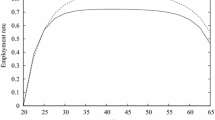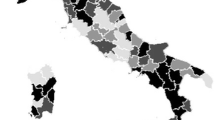Abstract
This paper shows that hiring discrimination against old workers occurs in imperfect labour markets even if individual productivity does not decrease with age and in the absence of a taste for discrimination. Search and informational frictions generate unemployment, with less productive workers facing higher risks of unemployment. Therefore, the employment status provides a signal for expected productivity. This stigma of unemployment becomes stronger with individual age and reduces the hiring opportunities of older workers. Political measures such as a reduction in dismissal protection can help to restore efficiency.


Similar content being viewed by others
Notes
Nevertheless, discrimination could persist in the presence of search frictions, see for example Lang et al. (2005).
A sufficiently large \(\gamma \) limits the role of complementarities in the potential equilibrium, because expectations only matter if the productivity is not observed. Low \(\gamma \) would prohibit a clear selection of equilibria. In order to retain tractability, I assume that a worker’s productivity can be observed sufficiently often. If \(\gamma \) was too small, we could generate additional, counterfactual equilibria in which two young workers decline, but two old workers who have worse prerequisites cooperate (see Appendix for a discussion of the thresholds).
This is the probability that cooperation with any agent takes place, so a firm with an unproductive agent is treated as employment. The results do not change qualitatively if I only consider firms with productive workers.
References
Aliprantis C, Camera G, Puzzello D (2007) A random matching theory. Games Econ Behav 59:1–16
Arrow KJ (1973) The theory of discrimination. In: Ashenfelter O, Rees A (eds) Discrimination in labor markets. Princeton University Press, Princeton, pp 3–33
Becker GS (1957) The economics of discrimination. The University of Chicago Press, Chicago
Blankenau W, Camera G (2006) A simple economic theory of skill accumulation and schooling decisions. Rev Econ Dyn 9:93–115
Heywood JS, Ho L-S, Wei X (1999) The determinants of hiring older workers: evidence from Hong Kong. Ind Labor Relat Rev 52:444–459
Heywood JS, Jirjahn U, Tsertsvardze G (2010) Hiring older workers and employing older workers: German evidence. J Popul Econ 23:595–615
Hirsch BT, Macpherson DA, Hardy MA (2000) Occupational age structure and access for older workers. Ind Labor Relat Rev 53:401–418
Hutchens R (1986) Delayed payment contracts and a firm’s prospensity to hire older workers. J Labor Econ 4:439–457
Kugler AD, Saint-Paul G (2004) How do firing costs affect worker flows in a world with adverse selection?J Labor Econ 22(3):553–584
Lang K, Manove M, Dickens W (2005) Racial discrimination in labor markets with posted wage offers. Am Econ Rev 95:1327–1340
Lockwood B (1991) Information externalities in the labour market and the duration of unemployment. Rev Econ Stud 58:733–753
Oberholzer-Gee F (2008) Nonemployment stigma as rational herding: a field experiment. J Econ Behav Organ 65:30–40
Phelps ES (1972) The statistical theory of racism and sexism. Am Econ Rev 62:659–661
Skirbekk V (2004) Age and individual productivity: a literature survey. In: Feichtinger G (ed) Vienna yearbook of population research. Verlag der Österreichischen Akademie der Wissenschaften, Vienna, pp 133–153
Acknowledgments
I am grateful to Leo Kaas, Carlos Alós–Ferrer, Friedrich Breyer, Stefan Zink and two anonymous referees for the numerous helpful comments and remarks.
Author information
Authors and Affiliations
Corresponding author
Additional information
Responsible editor: Alessandro Cigno
Appendix
Appendix
1.1 Proof of Proposition 1
In order to prove Proposition 1, I derive a sufficient condition such that both \(L_0(\textrm {y,y})\) and \(L_1(\textrm {y,y})\) are strictly larger than all other thresholds for any \(\boldsymbol {\omega }\). Under Assumption 1, at the thresholds for two young workers \(L_1(\textrm {y,y})\) and \(L_0(\textrm {y,y})\), L is so high that no cooperation involving at least one old worker and unobservable productivity is possible even for the most extreme expectations, so we know that \(L_1(\textrm {y,y})=L_1(\textrm {y,y})(0,0,0,1)\) and \(L_0(\textrm {y,y})=L_0(\textrm {y,y})(0,0,0,0)\). Inversely, at levels of dismissal protection if two old workers or workers in mixed matches are indifferent between cooperation and non-cooperation, two young workers must strictly prefer to cooperate. That is, \(L_1(\textrm {y,o})(\omega _{\textrm {oy}},\omega _{\textrm {yy}})=L_1(\textrm {y,o})(\omega _{\textrm {oy}},1)\), \( L_1(\textrm {o,o})=L_1(\textrm {o,o})(1)\) and \(L_0(\textrm {o,o})=L_0(\textrm {o,o})(1)\).
This is easy to check for \(L_1(\textrm {y,y})\): the incentives to cooperate with an agent whose productivity cannot be observed are the highest if two young workers are matched. Young unemployed agents are on average more productive (\(P_{\textrm {y}}>P_{\textrm {o}}\)(\(\omega _{\textrm {yy}}\))), and a match of this kind promises additional income \(2G-U_{\textrm {o}}({\boldsymbol {\omega }})>G\). Therefore, cooperation between two young workers (\( \omega _{\textrm {yy}}=1\)) can occur even if dismissal protection is too tough to allow for any other kind of collaboration, so \(L_1(\textrm {y,y})\) is strictly larger than any other threshold.
However, it holds for \(L_0(\textrm {y,y})\) only if
Since \(U_{\textrm {o}}(\boldsymbol {\omega })\) is strictly decreasing in L and \(\omega _{\textrm {yy}}\) and I am only interested in a sufficient condition, I can assume \(L=0\) and \( \omega _{\textrm {yy}}=0\). For \(L=0\), \(U_{\textrm {o}}(\boldsymbol {\omega })\) is strictly increasing in \(\omega _{\textrm {oo}},\omega _{\textrm {yo}}\) and \(\omega _{\textrm {oy}}\), so I use \(U(1,1,1,0)\). Now, I can rewrite Eq. 20 as
The right-hand side of Eq. 21 is increasing in \(O(0)\), so I substitute \(P_{\textrm {y}}\) for \(O(0)\) as \(P_{\textrm {y}}>O(0)\) to obtain the sufficient condition
This inequality holds if \(\gamma \) is sufficiently large and \(P_{\textrm {y}}\) is sufficiently small. Figure 3 shows the combinations of \(P_{\textrm {y}}\) and \(\gamma \) that satisfy Assumption 1.
This sufficient condition is very loose (assuming \(L=0\), etc.); thus, even a higher fraction of productive workers should support this equilibrium once I impose restrictions on \(G/L\).
1.2 Proof of Proposition 2
To determine \(L_1(\textrm {y,o})(\omega _{\textrm {oy}})\) and \(L_1(\textrm {o,y})\), first note that \(L_0(\textrm {o,o})\le L_1(\textrm {y,o})(\omega _{\textrm {oy}})\le L_1(\textrm {o,o})\) (because \( L_1(\textrm {y,o})(0)=L_0(\textrm {o,o})\) and \(L_1(\textrm {y,o})(1)=L_1(\textrm {o,o})\)) and \(L_1(\textrm {o,y})>L_0(\textrm {o,o})\). The threshold for an old worker in order to cooperate with a young one depends on the expected behaviour of that young agent (and vice versa). That is, the position of one threshold has an impact on the position of the other. There could be three different cases:
-
1.
First consider \(L_1(\textrm {o,y})<L_1(\textrm {y,o})(\omega _{\textrm {oy}})\). This implies \(L_1(\textrm {o,y})=L_1(\textrm {o,y})(1)\) and \(L_1(\textrm {y,o})=L_1(\textrm {y,o})(0)\), so
$$ L_1(\textrm{o,y})(1)=\frac{P_{\textrm{y}}G}{1-P_{\textrm{y}}} \textrm{ and } $$(23)$$ L_1(\textrm{y,o})(0)=\frac{P_{\textrm{o}}(1)\gamma G}{1-P_{\textrm{o}}(1)}. $$(24)It is easy to check that then \(L_1(\textrm {o,y})(1)>L_1(\textrm {y,o})(0)\), which contradicts the assumption \(L_1(\textrm {o,y})<L_1(\textrm {y,o})(\omega _{\textrm {oy}})\).
-
2.
Now consider the case \(L_1(\textrm {o,y})=L_1(\textrm {y,o})\):
$$ \frac{P_{\textrm{y}}(\gamma+(1-\gamma)\omega_{\textrm{yo}})G}{1-P_{\textrm{y}}}=\frac{ P_{\textrm{o}}(1)(\gamma+(1-\gamma)\omega_{\textrm{oy}})G}{1-P_{\textrm{o}}(1)} $$(25)This can only be satisfied if \(\omega _{\textrm {oy}}\) at the right-hand side is to a sufficient degree larger than \(\omega _{\textrm {yo}}\) at the left-hand side in order to outweigh \(P_{\textrm {o}}(1)<P_{\textrm {y}}\). When does a combination of strategies \(\omega _{\textrm {yo}}\) and \(\omega _{\textrm {oy}}\) exist such that \(L_1(\textrm {o,y})=L_1(\textrm {y,o}) \) can hold? I substitute \(P_{\textrm {o}}(1)=1-\frac {\sqrt {1-P_{\textrm {y}}}}{\sqrt {1+P_{\textrm {y}}}}\) and obtain
$$ P_{\textrm{y}}[\gamma+(1-\gamma)\omega_{\textrm{yo}}]=\left[\sqrt{1-P_{\textrm{y}}^2}-(1-P_{\textrm{y}})\right] [\gamma+(1-\gamma)\omega_{\textrm{oy}}]. $$(26)This can only hold if \(\omega _{\textrm {oy}}>\omega _{\textrm {yo}}\). If even for \(\omega _{\textrm {oy}}=1\) and \(\omega _{\textrm {yo}}=0\) the left-hand side is larger than the right-hand side, no combination of \(\omega _{\textrm {oy}}\) and \(\omega _{\textrm {yo}}\) exists such that the two thresholds can coincide.
Result:
For \(\gamma \le \frac {\sqrt {1-P_{\textrm {y}}^2}-(1-P_{\textrm {y}})}{P_{\textrm {y}}}\), some combinations of \( \omega _{\textrm {oy}}\) and \(\omega _{\textrm {yo}}\) exist with \(\omega _{\textrm {oy}}>\omega _{\textrm {yo}}\) such that \(L_0(\textrm {o,o})<L_1(\textrm {o,y})=L_1(\textrm {y,o})(\omega _{\textrm {oy}})\le L_1(\textrm {o,o})\). There can be different thresholds with \(L_1(\textrm {y,o})=L_1(\textrm {o,y}) \in [L_0(\textrm {o,o}),L_1(\textrm {o,o})]\) because there are different combinations of \(\omega _{\textrm {oy}}\) and \(\omega _{\textrm {yo}}\) that support this condition.
-
3.
Assume \(L_1(\textrm {o,y})>L_1(\textrm {y,o})(\omega _{\textrm {oy}})\). This implies \( L_1(\textrm {o,y})=L_1(\textrm {o,y})(0)\) and \(L_1(\textrm {y,o})=L_1(\textrm {y,o})(1)\). Then,
$$ L_1(\textrm{o,y})(0)=\frac{P_{\textrm{y}}\gamma G}{1-P_{\textrm{y}}}\textrm{and} $$(27)$$ L_1(\textrm{y,o})(1)=\frac{P_{\textrm{o}}(1)G}{1-P_{\textrm{o}}(1)}. $$(28)So \(L_1(\textrm {o,y})>L_1(\textrm {y,o})\) is an equilibrium if
$$ \frac{P_{\textrm{y}} \gamma G}{1-P_{\textrm{y}}}>\frac{P_{\textrm{o}}(1)G}{1-P_{\textrm{o}}(1)}, $$(29)$$ \gamma > \frac{\sqrt{1-P_{\textrm{y}}^2}-(1-P_{\textrm{y}})}{P_{\textrm{y}}}. $$(30)Result:
For \(\gamma > \frac {\sqrt {1-P_{\textrm {y}}^2}-(1-P_{\textrm {y}})}{P_{\textrm {y}} }\), \( L_1(\textrm {o,y})=L_1(\textrm {o,y})(0)>L_1(\textrm {y,o})=L_1(\textrm {y,o})(1)=L_1(\textrm {o,o})\) is the only equilibrium (Fig. 4).
Rights and permissions
About this article
Cite this article
Manger, C. Endogenous age discrimination. J Popul Econ 27, 1087–1106 (2014). https://doi.org/10.1007/s00148-013-0467-7
Received:
Accepted:
Published:
Issue Date:
DOI: https://doi.org/10.1007/s00148-013-0467-7






